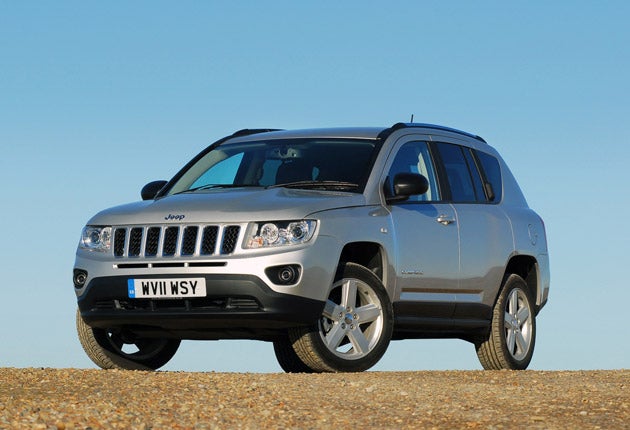Jeep Compass
Chrysler has given its new Jeep a dashing new face, new engines and – at last – a bit of attitude

Your support helps us to tell the story
From reproductive rights to climate change to Big Tech, The Independent is on the ground when the story is developing. Whether it's investigating the financials of Elon Musk's pro-Trump PAC or producing our latest documentary, 'The A Word', which shines a light on the American women fighting for reproductive rights, we know how important it is to parse out the facts from the messaging.
At such a critical moment in US history, we need reporters on the ground. Your donation allows us to keep sending journalists to speak to both sides of the story.
The Independent is trusted by Americans across the entire political spectrum. And unlike many other quality news outlets, we choose not to lock Americans out of our reporting and analysis with paywalls. We believe quality journalism should be available to everyone, paid for by those who can afford it.
Your support makes all the difference.Is it a real Jeep? Well, it has seven vertical slots in its front grille, wheel arches which look as though they should contain square wheels, plenty of ground clearance, and quite a rugged demeanour. And, of course, it has four-wheel drive.
Or does it? We'll get back to this in a minute, but the main point is that the Jeep Compass, recently absent from the price lists, is back with a new face, new engines and a bit more perceived quality.
It's a bit complicated, actually. Fiat, having taken over Chrysler, which makes Jeeps, has had to rethink how Chrysler products are sold in Europe. This has had some strange effects on what constitutes a Chrysler – Lancia is shortly to re-enter the UK market, for example, but for us the cars will be Chrysler-badged – and the Jeep range of 4x4s has been stirred around a bit. There already was a Compass, the "softest" Jeep and a rather timid production version of a clever, nautically flavoured concept car from a decade ago, and there was – indeed still is – also the Patriot, which is squarer-cut but mechanically almost identical to the Compass. It looks tougher, but isn't.
Poor sales killed off the Compass here, because it seemed a pointless car, a Patriot without attitude. Now it has been re-cast as a sort of mini-Grand Cherokee (the poshest Jeep), a change signified by the new nose design. The Jeep marketing people even go so far as to declare it a "premium" product. More important are the mechanical changes, chief of which is the new Mercedes diesel engine in place of the old-tech Volkswagen unit (in an American car made by a Fiat-owned company). It's incestuous, this motor-industry business.
This car is about having a good time in places not necessarily accessible to the average car and driver, usually more through mindset than physical ability. The Jeep publicists' vision is of a Compass on a beach forming a backdrop to a barbecue, tailgate open, loudspeakers hinged downwards to broadcast bluegrass across the sand. You might have needed four-wheel drive to get there, you might not. Which means you shouldn't be embarrassed if you chose one of the two cheaper Compasses, which now come with front-wheel drive only.
These cheaper Compasses come with a 2.0-litre, 154bhp petrol engine or a 134bhp version of the turbodiesel. The 4x4 versions can have a 2.4-litre, 168bhp petrol engine mated to a continuously variable automatic transmission (pay for the indulgence with a 199g/km CO2 figure) or the more powerful, 161bhp diesel. Trim levels are Sport, Sport +, Limited (a curious Americanism) and 70th Anniversary (the poshest, celebrating the original Jeep's invention during the Second World War).
I drove a Limited 4x4 with the more muscular diesel engine, and frankly I was surprised. The driving position is commanding and the engine is quite refined. It's also punchy enough to move the Compass with relaxed vigour, and it would make a good towing car.
The best part, though, is the way it steers with a precision not normally found in Jeeps. It goes where pointed and rides with enough suppleness to be comfortable, enough tautness not to heave and wallow. Firmer springs and dampers, auxiliary rebound springs, and a thicker rear anti-roll bar are the key to the transformation.
Most of the time you'll be unaware of the four-wheel drive system which feeds the front wheels only until they start to slip. Torque is then diverted progressively rearwards via a clutch, which can also be locked solid for off-roading. There's no system of automatic braking for picking your way down a precipitous mountain track, but there is Electronic Roll Mitigation, which discourages the Compass from falling over in an "extreme" manoeuvre. That's comforting.
Anyway, here's the clincher. No equivalent rival is cheaper than the Compass – the range starts at £16,995. And it does come from a proper 4x4 brand. This time around, it's a Compass with credibility.
The Rivals
Kia Sportage 2.0 CRDi KX-3 4WD: £24,420, 136bhp, 156g/km
Korean brand, striking European design, good finish, cuts a dash. High waistline makes it feel bulky to drive.
Nissan Qashqai 2.0 dCi Tekna 4WD: £26,645, 150bhp, 163g/km
Most expensive Qashqai bridges gap between family hatchback and SUV. Good to drive, expensive for what it is.
Vauxhall Antara 2.2 CDTI 184 SE: £25,455, 184bhp, 175g/km
British brand, Korean manufacture, European development. Antara is now a refined, competitive car – but not a cheap one.
Join our commenting forum
Join thought-provoking conversations, follow other Independent readers and see their replies
Comments